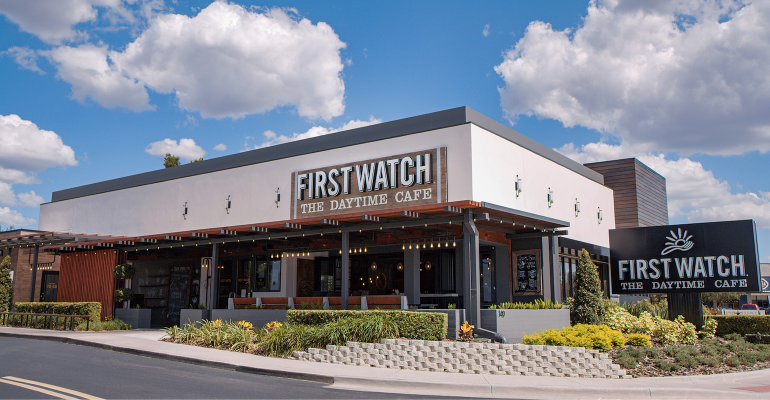First Watch Restaurant Group Inc. maintained its full menu and kept full service hours as it emerged from the pandemic, which helped it post 36.7% same-store sales growth in the fourth quarter ended Dec. 26, company executives said Monday.
“We tried to be as much business as usual for our customers when they came back.,” said Chris Tomasso, CEO and president of the Bradenton, Fla.-based daytime brand, at the virtual ICR Conference. “They've had enough disruption in their lives because of COVID, and we didn't want to be another source of that.
“If anything, we wanted to be a comfort zone for them,” Tomasso said.
First Watch, which went public with a $170 million IPO in October, on Monday reported same-store traffic was up 6.1% from the fourth quarter of pre-pandemic 2019 and same-store sales were up 20.1% in the same period.
Over the past two years, the 428-unit First Watch chain has added alcohol service in many locations, expanded a fresh juice program and modernized the menu for the 7 a.m.-2:30 p.m. concept. The company also introduced a new prototype that aims to balance a growing to-go business with in-store dining.
“We see we see ourselves as a disruptor of a segment that frankly hasn't had much innovation over the years,” Tomasso said.
“We see that as a way to widen the competitive moat,” he said.
In 2021, Tomasso said First Watch did not increase any prices and was able to maintain its service staffing, which he said helped increase traffic.
“I believe it has to do with the uniqueness of our offering the daytime dining,” he said, “specifically because we haven't faced the same labor challenges that others in our industry” has suffered.
Tomasso likened consumer reaction to that in the Great Recession in 2008-2010. “We just felt like a lot of people turned to us for that consistency, that comfortable environment and experience that they enjoyed,” he said.
Mel Hope, First Watch’s chief financial officer, added that “we needed to be sure we were reliable. … People are counting their favorite restaurant being there. It was important for us to be reliable and dependable and open all the time.”
First Watch has also benefited from data provided through online ordering and other digital tools. The company still only spends about 1% of sales on marketing, but the new data pools of loyal customers have allowed it to be more targeted in the approach, Tomasso said.
“We've had customer data inputs for a long time,” he said, “but we never really leveraged them.” Now the brand’s smartphone app, wait-list tool and WiFi log-ins provide data that can be applied to marketing, he said.
“All of those things now are being pulled into a data lake, as we call it, and we can leverage it a lot more,” Tomasso said. “it's the difference between marketing with a scalpel versus a broad-based approach.”
For the third quarter ended Sept. 26, First Watch swung to a profit of $783,000, or 2 cents a share, from a loss of $11.1 million, or 25 cents a share, in the prior-year period. Revenues increased 57.8%, to $157.4 million, from $99.7 million in the same quarter last year.
As of Dec. 26, First Watch had 435 restaurants in 28 states. Of those, 341 were company-owned and 94 franchised. The brand was founded in 1983.
Contact Ron Ruggless at [email protected]
Follow him on Twitter: @RonRuggless




